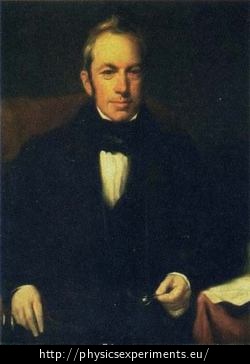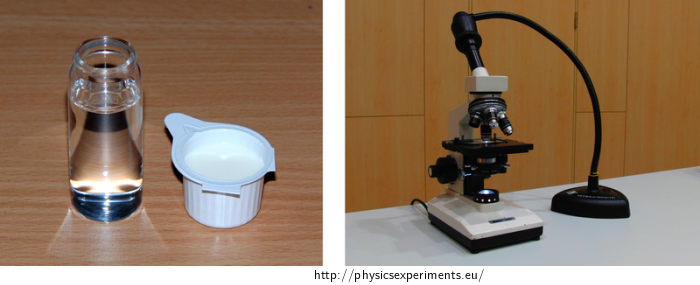Brownian Motion
Experiment number : 1944
Goal of experiment
The goal of this experiment is to show real Brownian motion using a microscope.
Theory
In 1827, a Scottish botanist Robert Brown (1773–1857, Fig. 1) observed a chaotic motion of tiny particles ejected from pollen seeds suspended in water for the first time. This movement, named after its discoverer, had seemingly no cause and resisted the scientific efforts to explain it; until Albert Einstein and Marian Smoluchowski independently discovered the correct explanation in 1905 and 1906 respectively. The explanation is based on the kinetic theory of matter and justifies the movement of pollen particles (so called brownian particles) by their collisions with much smaller water molecules. These chaotically moving molecules collide with the particle in all directions and when the acting force is stronger in the short term from one direction, the water molecules grant the particle acceleration in that direction; everything then repeats in a new location. The resulting motion is therefore disordered and abrupt.

Brownian motion is considered one of the experimental proofs that particles in matter constantly move in a disordered fashion.
Tools
Microscope, cream, slide and a coverslip, brush, container filled with water.
Procedure
First we prepare the solution for studying Brownian motion. We add a few drops of cream (Fig. 2 on the left) to approximately 20 ml of water with a brush and stir the solution.
We apply a sample of the solution onto a slide and cover it with a coverslip.
We put the sample under a microscope and focus the picture. We observe directly through the eyepiece lens or attach a video recorder to it (Fig. 2 on the right) and project the picture on a projection screen.
Sample result
We observe Brownian motion, where the particles of fat from the cream act as Brownian particles and water is the environment – as it was in the original experiment of Robert Brown. Sample result is shown in the video below, where 600× magnification was used.
Technical notes
If we want to prepare our sample before class, we need to keep it in the container, not between the slide and the coverslip – there it quickly dries out.
If we have a microscope with a wireless, USB, or another type of connection, we can show the experiment on a computer monitor or a projection screen.
Simple compact digital USB microscopes offering a maximum magnification of for example 220 or 400 are an available teaching tool. Unfortunately, the authors of this experiment could not capture Brownian motion using these devices.
Pedagogical notes
We can come in the classroom with an already prepared solution, which eliminates the risk of failing to prepare the appropriate sample. However, it can be beneficial for students to observe the preparation of the solution or even partake in it – then it is necessary to find out the correct ratio of cream and water beforehand.
The course of the experiment itself deserves commentary from the teacher, because more things typically happen at once. Most notably – not only do the Brownian particles oscillate chaotically, the sample as a whole moves in one direction – we call this flow of the sample and it is important to highlight that this phenomenon is not related to Brownian motion. Flowing occurs for example when the sample streams down the slide due to the gravitational force or when it is unevenly heated by the lamp of the microscope. Sometimes, in addition to Brownian motion, we can also notice the motion of living microorganisms.
Students sometimes wonder why some Brownian particles appear small and others dark and many even “change colour” during the experiment. These effects are a result of the wave-like nature of light, or more precisely interference/diffraction on the observed particles.
Comment
A microscope suitable for this experiment is not available in every school. We can resort to an animation or an applet in case of its absence. These exist in varying quantities on many places on the internet – we can recommend for example this animation of Brownian motion published on YouTube:
Trivia
Einstein’s article On the Motion of Small Particles Suspended in Liquids at Rest Required by the Molecular-Kinetic Theory of Heat from 1905, which is usually thought to be the explanation of Brownian motion, strangely does not mention this motion at all – the article had a different goal and only in its making did Einstein probably realise its connection to Brownian motion.








